2004 PONTIAC BONNEVILLE brake light
[x] Cancel search: brake lightPage 320 of 446
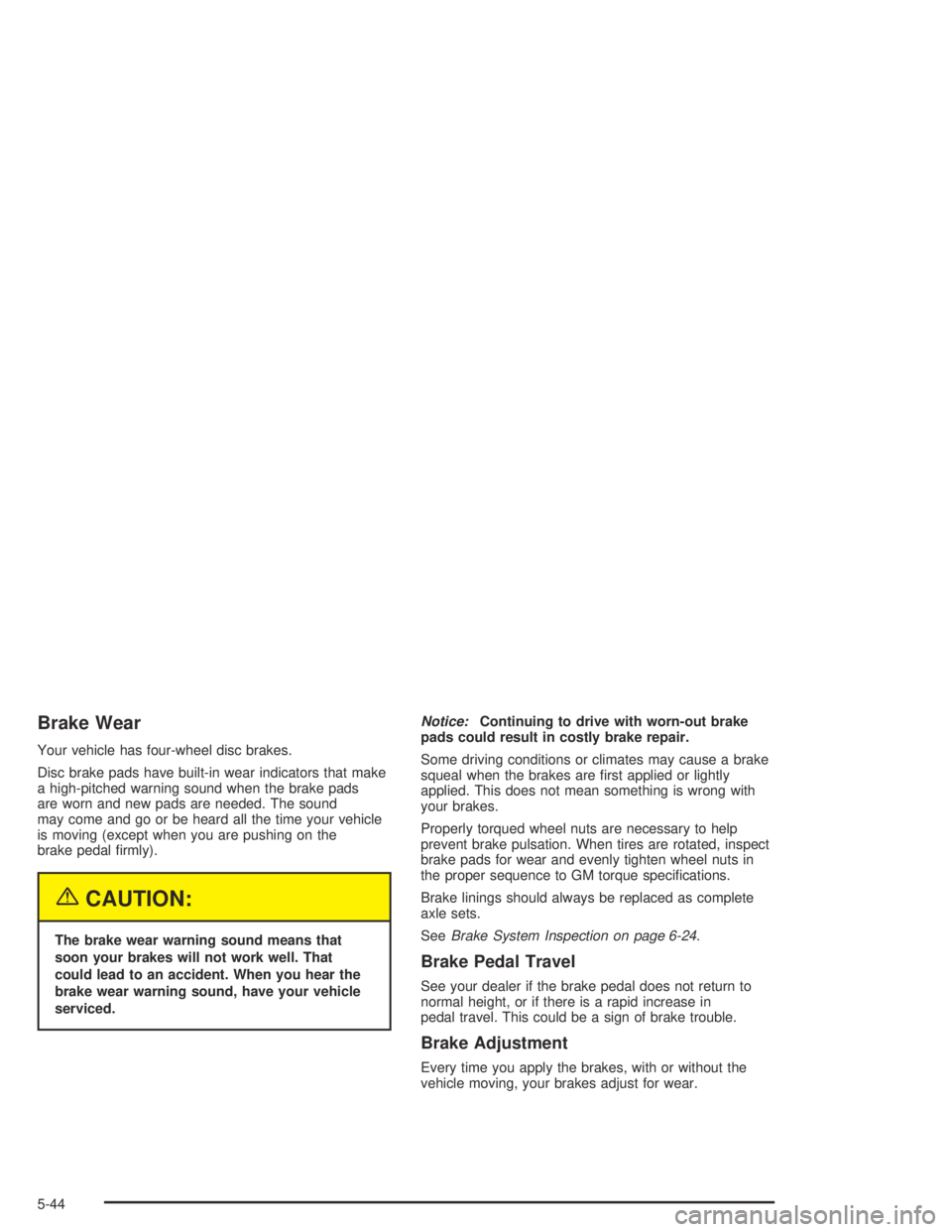
Brake Wear
Your vehicle has four-wheel disc brakes.
Disc brake pads have built-in wear indicators that make
a high-pitched warning sound when the brake pads
are worn and new pads are needed. The sound
may come and go or be heard all the time your vehicle
is moving (except when you are pushing on the
brake pedal �rmly).
{CAUTION:
The brake wear warning sound means that
soon your brakes will not work well. That
could lead to an accident. When you hear the
brake wear warning sound, have your vehicle
serviced.Notice:Continuing to drive with worn-out brake
pads could result in costly brake repair.
Some driving conditions or climates may cause a brake
squeal when the brakes are �rst applied or lightly
applied. This does not mean something is wrong with
your brakes.
Properly torqued wheel nuts are necessary to help
prevent brake pulsation. When tires are rotated, inspect
brake pads for wear and evenly tighten wheel nuts in
the proper sequence to GM torque speci�cations.
Brake linings should always be replaced as complete
axle sets.
SeeBrake System Inspection on page 6-24.
Brake Pedal Travel
See your dealer if the brake pedal does not return to
normal height, or if there is a rapid increase in
pedal travel. This could be a sign of brake trouble.
Brake Adjustment
Every time you apply the brakes, with or without the
vehicle moving, your brakes adjust for wear.
5-44
Page 323 of 446
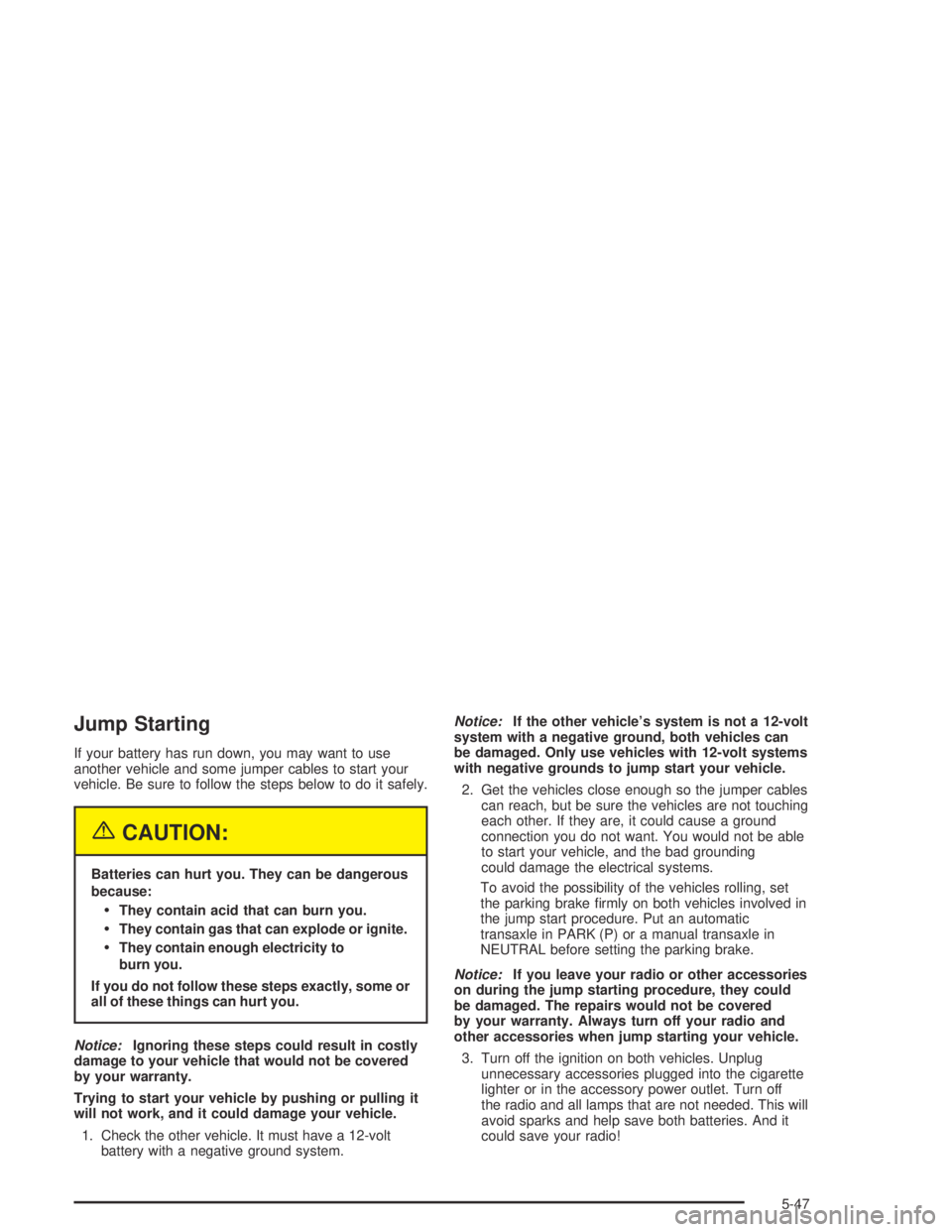
Jump Starting
If your battery has run down, you may want to use
another vehicle and some jumper cables to start your
vehicle. Be sure to follow the steps below to do it safely.
{CAUTION:
Batteries can hurt you. They can be dangerous
because:
They contain acid that can burn you.
They contain gas that can explode or ignite.
They contain enough electricity to
burn you.
If you do not follow these steps exactly, some or
all of these things can hurt you.
Notice:Ignoring these steps could result in costly
damage to your vehicle that would not be covered
by your warranty.
Trying to start your vehicle by pushing or pulling it
will not work, and it could damage your vehicle.
1. Check the other vehicle. It must have a 12-volt
battery with a negative ground system.Notice:If the other vehicle’s system is not a 12-volt
system with a negative ground, both vehicles can
be damaged. Only use vehicles with 12-volt systems
with negative grounds to jump start your vehicle.
2. Get the vehicles close enough so the jumper cables
can reach, but be sure the vehicles are not touching
each other. If they are, it could cause a ground
connection you do not want. You would not be able
to start your vehicle, and the bad grounding
could damage the electrical systems.
To avoid the possibility of the vehicles rolling, set
the parking brake �rmly on both vehicles involved in
the jump start procedure. Put an automatic
transaxle in PARK (P) or a manual transaxle in
NEUTRAL before setting the parking brake.
Notice:If you leave your radio or other accessories
on during the jump starting procedure, they could
be damaged. The repairs would not be covered
by your warranty. Always turn off your radio and
other accessories when jump starting your vehicle.
3. Turn off the ignition on both vehicles. Unplug
unnecessary accessories plugged into the cigarette
lighter or in the accessory power outlet. Turn off
the radio and all lamps that are not needed. This will
avoid sparks and help save both batteries. And it
could save your radio!
5-47
Page 344 of 446

When to Check
Check your tires once a month or more.
Don’t forget your compact spare tire. It should be at
60 psi (420 kPa).
How to Check
Use a good quality pocket-type gage to check tire
pressure. You can’t tell if your tires are properly in�ated
simply by looking at them. Radial tires may look
properly in�ated even when they’re underin�ated.
Remove the valve cap from the tire valve stem. Press
the tire gage �rmly onto the valve to get a pressure
measurement. If the cold tire in�ation pressure matches
the recommended pressure on the tire and loading
information label, no further adjustment is necessary. If
the in�ation pressure is low, add air until you reach
the recommended amount. Be sure to put the valve caps
back on the valve stems. They help prevent leaks by
keeping out dirt and moisture.
If you over�ll the tire, release air by pushing on the
metal stem in the center of the tire valve. Recheck the
tire pressure with the tire gage.
Be sure to put the valve caps back on the valve stems.
They help prevent leaks by keeping out dirt and
moisture.
Check Tire Pressure System
The check tire pressure system can alert you to a large
change in the pressure of one tire. The system will not
alert you before you drive that a tire is low or �at. You
must begin driving before the system will work properly.
The CHECK TIRE PRESSURE message will appear on
the Driver Information Center (DIC) or the system
monitor TIRE PRESS light will come on if pressure
difference (low pressure) is detected in one tire.
The check tire pressure system may not alert you if:
More than one tire is low.
The vehicle is moving faster than 65 mph (105 km/h).
The system is not yet calibrated.
The compact spare tire is installed.
The tire treadwear is uneven.
Tire chains are being used.
The vehicle is being driven on a rough or frozen road.
If the anti-lock brake system warning light comes on,
the check tire pressure system may not be working
properly. See your dealer for service. Also, see
Anti-Lock Brake System Warning Light on page 3-44.
5-68
Page 431 of 446
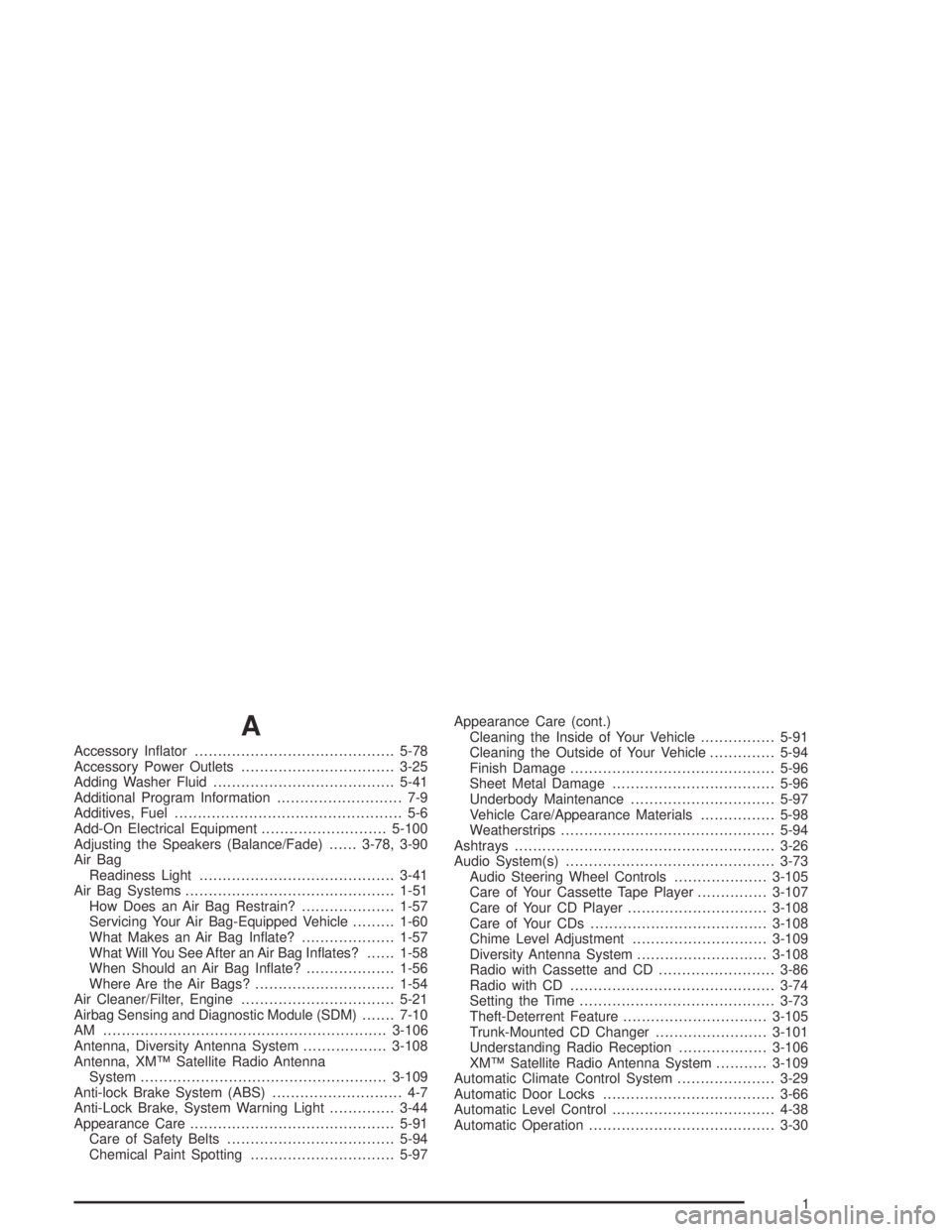
A
Accessory In�ator...........................................5-78
Accessory Power Outlets.................................3-25
Adding Washer Fluid.......................................5-41
Additional Program Information........................... 7-9
Additives, Fuel................................................. 5-6
Add-On Electrical Equipment...........................5-100
Adjusting the Speakers (Balance/Fade)......3-78, 3-90
Air Bag
Readiness Light..........................................3-41
Air Bag Systems.............................................1-51
How Does an Air Bag Restrain?....................1-57
Servicing Your Air Bag-Equipped Vehicle.........1-60
What Makes an Air Bag In�ate?....................1-57
What Will You See After an Air Bag In�ates?......1-58
When Should an Air Bag In�ate?...................1-56
Where Are the Air Bags?..............................1-54
Air Cleaner/Filter, Engine.................................5-21
Airbag Sensing and Diagnostic Module (SDM).......7-10
AM .............................................................3-106
Antenna, Diversity Antenna System..................3-108
Antenna, XM™ Satellite Radio Antenna
System.....................................................3-109
Anti-lock Brake System (ABS)............................ 4-7
Anti-Lock Brake, System Warning Light..............3-44
Appearance Care............................................5-91
Care of Safety Belts....................................5-94
Chemical Paint Spotting...............................5-97Appearance Care (cont.)
Cleaning the Inside of Your Vehicle................5-91
Cleaning the Outside of Your Vehicle..............5-94
Finish Damage............................................5-96
Sheet Metal Damage...................................5-96
Underbody Maintenance...............................5-97
Vehicle Care/Appearance Materials................5-98
Weatherstrips..............................................5-94
Ashtrays........................................................3-26
Audio System(s).............................................3-73
Audio Steering Wheel Controls....................3-105
Care of Your Cassette Tape Player...............3-107
Care of Your CD Player..............................3-108
Care of Your CDs......................................3-108
Chime Level Adjustment.............................3-109
Diversity Antenna System............................3-108
Radio with Cassette and CD.........................3-86
Radio with CD............................................3-74
Setting the Time..........................................3-73
Theft-Deterrent Feature...............................3-105
Trunk-Mounted CD Changer........................3-101
Understanding Radio Reception...................3-106
XM™ Satellite Radio Antenna System...........3-109
Automatic Climate Control System.....................3-29
Automatic Door Locks.....................................3-66
Automatic Level Control...................................4-38
Automatic Operation........................................3-30
1
Page 432 of 446

Automatic Transaxle
Fluid..........................................................5-23
Operation...................................................2-29
Automatic Transaxle Check..............................6-20
Automatic Transaxle Shift Lock Control System
Check........................................................6-21
B
Backing Up....................................................4-43
Battery..........................................................5-45
Battery Load Management...............................3-22
Battery Replacement......................................... 2-9
Before Leaving on a Long Trip.........................4-23
Body Lubrication Service..................................6-20
Brake
Parking......................................................2-32
System Inspection.......................................6-24
System Warning Light..................................3-42
Brake Fluid....................................................5-42
Brake Wear...................................................5-44
Brakes..........................................................5-42
Braking........................................................... 4-6
Braking in Emergencies..................................... 4-9
Break-In, New Vehicle.....................................2-25
Bulb Replacement...........................................5-52
Front Turn Signal and Parking Lamps.............5-54
Halogen Bulbs............................................5-52
Headlamps.................................................5-53Bulb Replacement (cont.)
Replacement Bulbs......................................5-57
Taillamps, Turn Signal, Stoplamps and
Back-up Lamps........................................5-56
Buying New Tires...........................................5-72
C
Calibrating the Compass..................................3-72
California Fuel.................................................. 5-6
Canada – Customer Assistance.......................... 7-4
Canadian Owners................................................ ii
Canadian Roadside Assistance........................... 7-7
Capacities and Speci�cations..........................5-109
Carbon Monoxide...................4-26, 4-39, 2-16, 2-37
Care of
Safety Belts................................................5-94
Your Cassette Tape Player..........................3-107
Your CD Player.........................................3-108
Your CDs .................................................3-108
Cassette Tape Messages.................................3-97
Cassette Tape Player Service...........................6-19
CD Adapter Kits.............................................3-98
CD Changer, Trunk-Mounted...........................3-101
CD Messages.............................3-86, 3-100, 3-104
Center Console Storage Area...........................2-48
Center Front Passenger Position, Safety Belts.......1-21
Chains, Tires..................................................5-77
Changing Your Zone Number............................3-71
2
Page 437 of 446
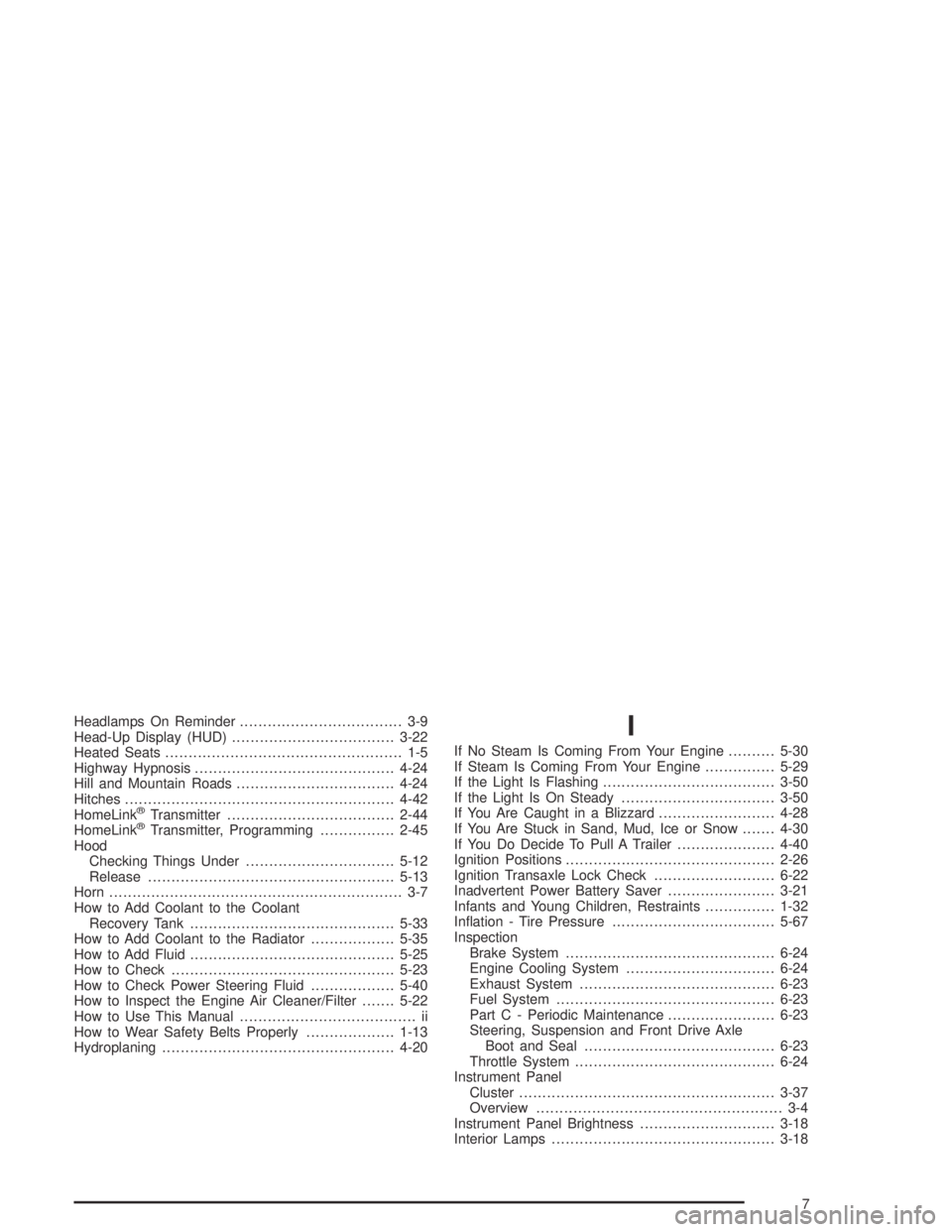
Headlamps On Reminder................................... 3-9
Head-Up Display (HUD)...................................3-22
Heated Seats................................................... 1-5
Highway Hypnosis...........................................4-24
Hill and Mountain Roads..................................4-24
Hitches..........................................................4-42
HomeLink
®Transmitter....................................2-44
HomeLink®Transmitter, Programming................2-45
Hood
Checking Things Under................................5-12
Release.....................................................5-13
Horn............................................................... 3-7
How to Add Coolant to the Coolant
Recovery Tank............................................5-33
How to Add Coolant to the Radiator..................5-35
How to Add Fluid............................................5-25
How to Check................................................5-23
How to Check Power Steering Fluid..................5-40
How to Inspect the Engine Air Cleaner/Filter.......5-22
How to Use This Manual...................................... ii
How to Wear Safety Belts Properly...................1-13
Hydroplaning..................................................4-20
I
If No Steam Is Coming From Your Engine..........5-30
If Steam Is Coming From Your Engine...............5-29
If the Light Is Flashing.....................................3-50
If the Light Is On Steady.................................3-50
If You Are Caught in a Blizzard.........................4-28
If You Are Stuck in Sand, Mud, Ice or Snow.......4-30
If You Do Decide To Pull A Trailer.....................4-40
Ignition Positions.............................................2-26
Ignition Transaxle Lock Check..........................6-22
Inadvertent Power Battery Saver.......................3-21
Infants and Young Children, Restraints...............1-32
In�ation - Tire Pressure...................................5-67
Inspection
Brake System.............................................6-24
Engine Cooling System................................6-24
Exhaust System..........................................6-23
Fuel System...............................................6-23
Part C - Periodic Maintenance.......................6-23
Steering, Suspension and Front Drive Axle
Boot and Seal.........................................6-23
Throttle System...........................................6-24
Instrument Panel
Cluster.......................................................3-37
Overview..................................................... 3-4
Instrument Panel Brightness.............................3-18
Interior Lamps................................................3-18
7
Page 438 of 446

J
Jump Starting.................................................5-47
K
Key Lock Cylinders Service..............................6-20
Key Reminder Warning....................................2-26
Keyless Entry System....................................... 2-5
Keys............................................................... 2-3
L
Lamps
Exterior......................................................3-14
Interior.......................................................3-18
Lap Belt........................................................1-21
Lap-Shoulder Belt...................................1-14, 1-23
LATCH System
Child Restraints...........................................1-42
Securing a Child Restraint Designed for the
LATCH System........................................1-44
Leaving Your Vehicle.......................................2-16
Leaving Your Vehicle With the Engine Running......2-35
Light
Air Bag Readiness.......................................3-41
Anti-Lock Brake System Warning...................3-44
Brake System Warning.................................3-42Light (cont.)
Check Gages Warning.................................3-54
Check Oil Level..........................................3-53
Door Ajar...................................................3-54
Low Traction Active......................................3-46
Low Washer Fluid Warning...........................3-53
Malfunction Indicator....................................3-48
Safety Belt Reminder...................................3-40
Security.....................................................3-53
Service Vehicle Soon...................................3-55
TCS Warning Light......................................3-45
Tire Pressure..............................................3-48
Traction Control System (TCS) Warning..........3-45
Trunk Ajar..................................................3-55
Loading Your Vehicle.......................................4-33
Lockout Protection..........................................2-16
Locks
Central Door Unlocking System.....................2-11
Delayed Locking..........................................2-12
Door..........................................................2-10
Leaving Your Vehicle....................................2-16
Lockout Protection.......................................2-16
Power Door................................................2-11
Programmable Automatic Door Locks.............2-13
Rear Door Security Locks.............................2-15
Long Trip/Highway De�nition.............................. 6-6
Long Trip/Highway Intervals............................... 6-6
Long Trip/Highway Scheduled Maintenance........6-13
Loss of Control...............................................4-15
8
Page 439 of 446
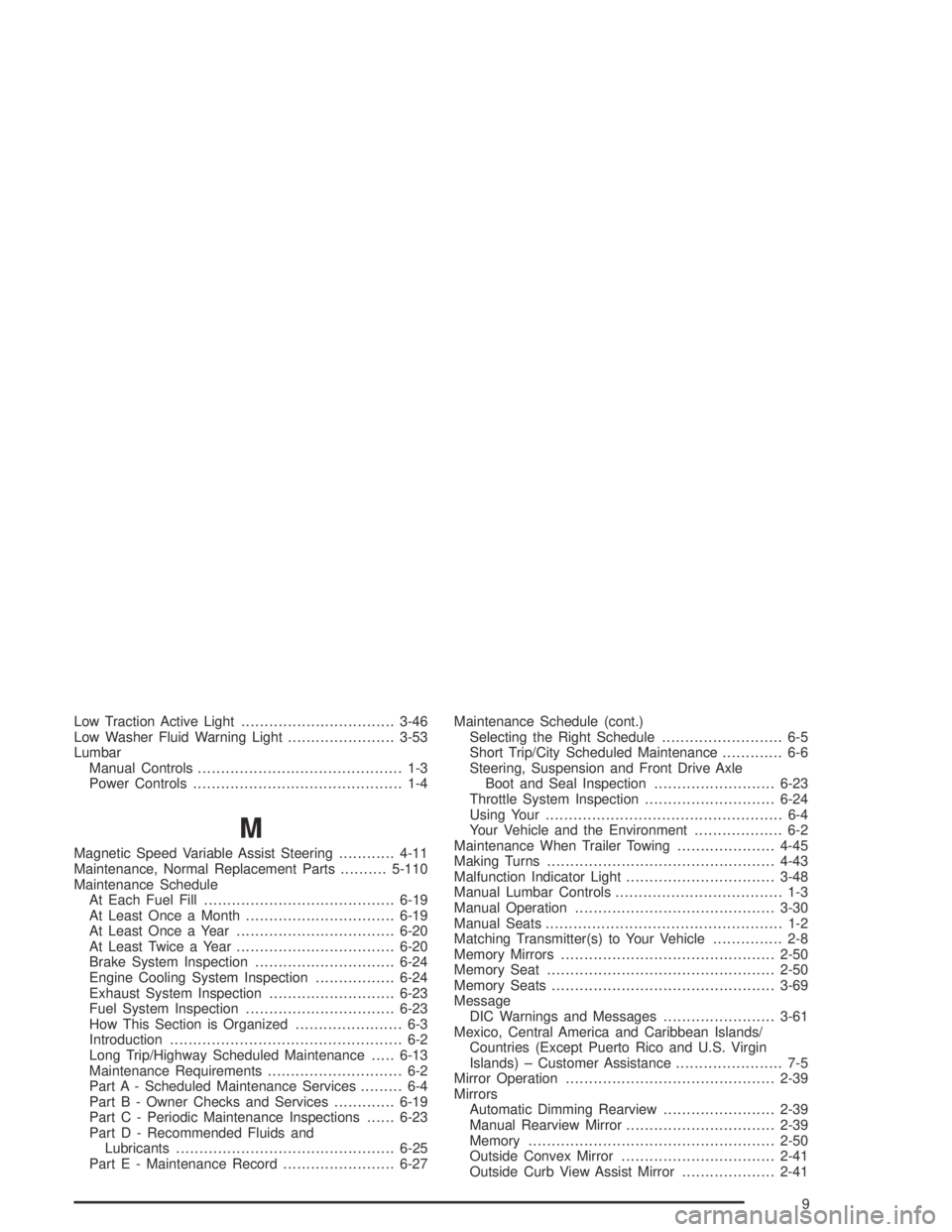
Low Traction Active Light.................................3-46
Low Washer Fluid Warning Light.......................3-53
Lumbar
Manual Controls............................................ 1-3
Power Controls............................................. 1-4
M
Magnetic Speed Variable Assist Steering............4-11
Maintenance, Normal Replacement Parts..........5-110
Maintenance Schedule
At Each Fuel Fill.........................................6-19
At Least Once a Month................................6-19
At Least Once a Year..................................6-20
At Least Twice a Year..................................6-20
Brake System Inspection..............................6-24
Engine Cooling System Inspection.................6-24
Exhaust System Inspection...........................6-23
Fuel System Inspection................................6-23
How This Section is Organized....................... 6-3
Introduction.................................................. 6-2
Long Trip/Highway Scheduled Maintenance.....6-13
Maintenance Requirements............................. 6-2
Part A - Scheduled Maintenance Services......... 6-4
Part B - Owner Checks and Services.............6-19
Part C - Periodic Maintenance Inspections......6-23
Part D - Recommended Fluids and
Lubricants...............................................6-25
Part E - Maintenance Record........................6-27Maintenance Schedule (cont.)
Selecting the Right Schedule.......................... 6-5
Short Trip/City Scheduled Maintenance............. 6-6
Steering, Suspension and Front Drive Axle
Boot and Seal Inspection..........................6-23
Throttle System Inspection............................6-24
Using Your................................................... 6-4
Your Vehicle and the Environment................... 6-2
Maintenance When Trailer Towing.....................4-45
Making Turns.................................................4-43
Malfunction Indicator Light................................3-48
Manual Lumbar Controls.................................... 1-3
Manual Operation...........................................3-30
Manual Seats................................................... 1-2
Matching Transmitter(s) to Your Vehicle............... 2-8
Memory Mirrors..............................................2-50
Memory Seat.................................................2-50
Memory Seats................................................3-69
Message
DIC Warnings and Messages........................3-61
Mexico, Central America and Caribbean Islands/
Countries (Except Puerto Rico and U.S. Virgin
Islands) – Customer Assistance....................... 7-5
Mirror Operation.............................................2-39
Mirrors
Automatic Dimming Rearview........................2-39
Manual Rearview Mirror................................2-39
Memory.....................................................2-50
Outside Convex Mirror.................................2-41
Outside Curb View Assist Mirror....................2-41
9